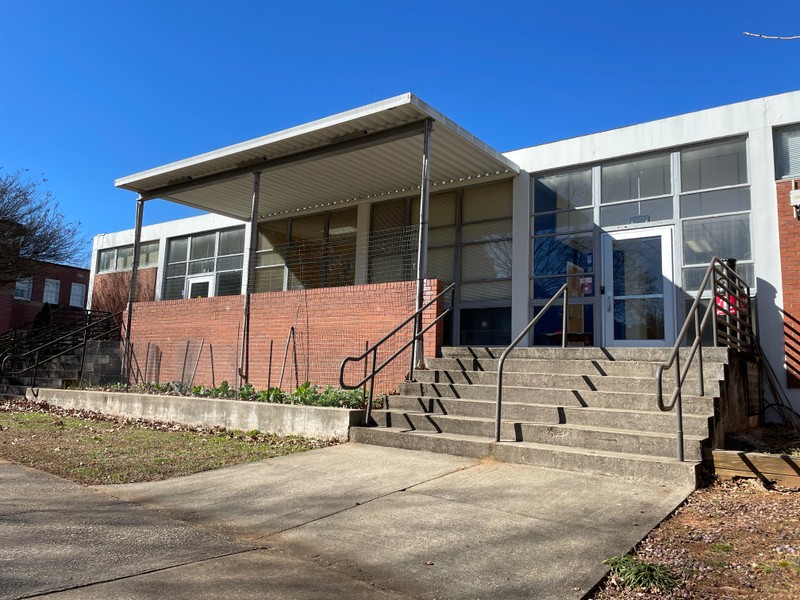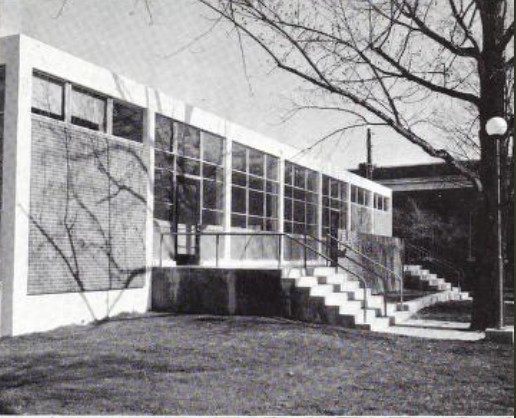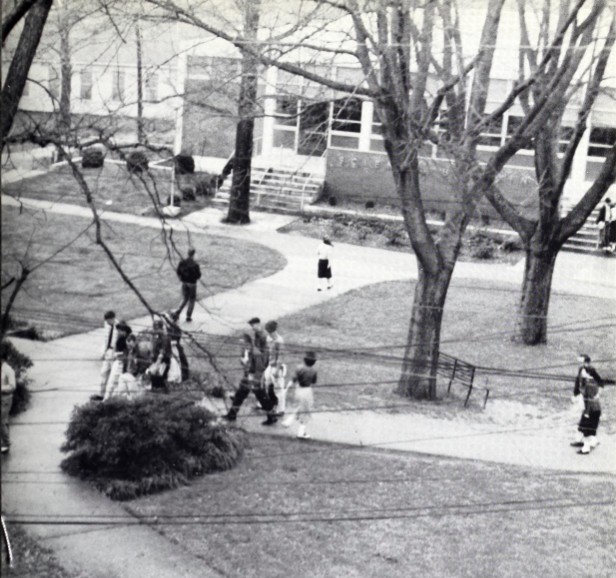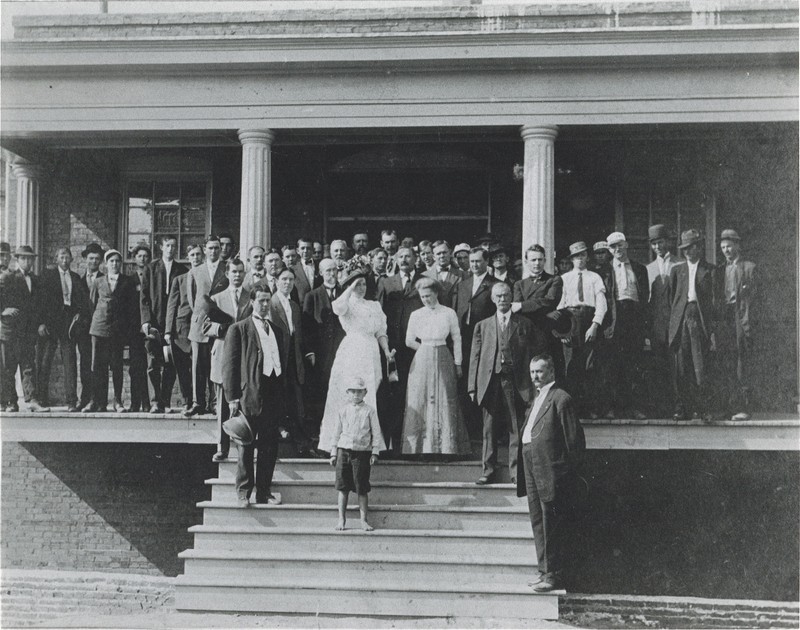Anthropology Building
Introduction
Author-Uploaded Audio
00:00 / 00:00
Introduction to the Anthropology Building.
Text-to-speech Audio
The Anthropology Building was built in 1954 as the Science and Student Activity Building, on what was previously West Georgia College's campus. It also stands where the Fourth District A&M School-era building Aycock Hall (1908-1944) used to stand before it burned down in 1944. The Anthropology Building is built in the International Style that was popular in the mid-twentieth century. This building has also housed the student center, the post office, and the college bookstore.
Images
Anthropology Building, 2021

Science Building, c. 1955

West Georgia College Students in front of the Science Building, c. 1957

West Georgia College cheerleaders and students at a pep rally in Carrollton's Adamson Square, 1951 (McGee's Bakery, which can be seen in the background, still operates in Carrollton, GA today.)

This photograph of a meeting at the Fourth District A&M School was taken in front of the original Aycock Hall, which was located where the Science Building was built in the 1950s. The Aycock Hall in this photograph was destroyed in a fire in the 1940s. Image dates from the early 1900s.

Backstory and Context
Author-Uploaded Audio
00:00 / 00:00
Listen to a narration of this entry's description by Center for Public History at the University at West Georgia University History Project.
Text-to-speech Audio
To continue our story: as a school connected to its community, West Georgia College was also affected by the start of World War II. The Army and the Navy designated West Georgia College as an accredited school for the training of young men for the military in northwest Georgia. Therefore, the College changed its curriculum to accommodate the physical education, mathematics, and other requirements of the military. The College’s pupils picked cotton for local farmers, collected scrap metal, wore U.S. colors, and participated in radio forums and speeches to keep the campus community updated on the war effort. However, not all students felt patriotic about the war effort, such as one who was quoted in the school’s newspaper, called The West Georgian, saying, “We are aware of this fact: there is a war in Europe and that is as far as most students’ interest goes. Sure people are being killed every day but many people are killed by automobiles in America and we don’t have to hear, see, and read of our butchery every minute of the day.”
World War II made a lasting impact on the College. President Ingram worked to update the Education curriculum with the collaboration of student and faculty input, in order to prepare white students to help their community and their country. Additionally, students founded a couple of new organizations on campus. One was the Democratic Youth Society in 1944 to sponsor speakers and discuss political affairs, and another was the Veterans Club, organized in 1946 to provide support and community to returning veterans.
The world and W.G.C. continued to change after World War II. In the 1950s with the rise of the Soviet Union in present-day Russia, many people in the U.S. experienced a widespread paranoia of communism and internal threats to American democracy, now known as the “Red Scare.” This phenomenon touched West Georgia College, as well. In 1954, Rebecca Lee, editor of The West Georgian wrote that dishonesty, which she claimed was inherent in Communism, was a great threat to democracy in the U.S. She called on her fellow students to fight subversion by avoiding being dishonest. In other articles, Lee expressed patriotic sentiments that readers were lucky to live in a country where they are “free.”
Another change in the United States in the 1950s was an increase in funding for science and technology. Ever heard of the Space Race? Space travel was one of the areas that the U.S. invested in. Another change at W.G.C. was the building of a new science building to promote science education, which brings us here. This building, now called the Anthropology Building, was completed in 1954 as the Science and Student Activity Building. There was such excitement when it was completed that Georgia Governor Herman Talmadge, the son of former governor Eugene Talmadge, visited campus for the dedication of the Science Building. Students and teachers attended from regional high schools for this major event, as well.
W.G.C. remained involved in the regional community throughout the 1950s. The school hosted West Georgia Intercollegiate Debate Tournaments, a music festival with northwest Georgia high schools and elementary school bands, and participated in College Days outreach events at local high schools. Another community collaboration was the West Georgia Health Institute, which met with local community members and health departments to discuss health issues such as mental health, dental health, and children’s health. Though not always involved in every aspect of the community, West Georgia College continued its tradition of remaining connected to northwest Georgia as a regional college.
Cite This Entry
Sarah I. Rodriguez. "Anthropology Building." Clio: Your Guide to History. August 20, 2021. Accessed April 9, 2025. https://theclio.com/tour/1804/5
Sources
Chieftain 1943, 7. https://archive.org/stream/chieftain19stud_8#page/n9/mode/2up/search/war.
Chieftain 1945, 44. https://archive.org/stream/chieftain19stud_10#page/44/mode/2up.
Chieftain 1946, 62. https://archive.org/stream/chieftain19stud_11#page/62/mode/2up.
“Fifteen Committees to Put West Georgia on War Duty By Jean Aycock.” West Georgian (Carrollton, GA) 9, no. 9 (February 24, 1942): 1, 4.
“Health Institute Now in Progress.” West Georgian (Carrollton, GA) 29, no. 2 (October 31, 1958): 1. https://gahistoricnewspapers.galileo.usg.edu/lccn/sn11890897/1958-10-31/ed-1/seq-1/.
Lee, Rebecca. “The Editor Says,” West Georgian (Carrollton, GA) 20, no. 5 (Mar. 1, 1954): 2. https://gahistoricnewspapers.galileo.usg.edu/lccn/sn11890897/1954-03-01/ed-1/seq-2/.
Lee, Rebecca. “The Editor Says.” West Georgian (Carrollton, GA) 20, no. 6 (Mar. 15, 1954): 2. https://gahistoricnewspapers.galileo.usg.edu/lccn/sn11890897/1954-03-15/ed-1/seq-2/.
Neese, Chelsea. "UHP_Campus Spaces MASTER_2019.08.20." University History Project. Carrollton: Center for Public History at the University of West Georgia, 2019. In the Center for Public History's possession.
“‘On the WarPath.’” West Georgian (Carrollton, GA) (October 24, 1939): 4.
“Post War Plans.” West Georgian (Carrollton, GA) 12, no. 4 (November 28, 1944): 1.
"Pres. Ingram Speaks On Post-War Planning." West Georgian (Carrollton, GA) (Jan. 28, 1944): 1, 6.
“Strict Physical Fitness Program for W.G.C. Youth.” West Georgian (Carrollton, GA) (July 10, 1942): 4.
“West Georgia War Effort.” West Georgian (Carrollton, GA) (October 13, 1942).
White, J. L. “Gov. Talmadge Speaks At West Georgia College.” West Georgian (Carrollton, GA) 20, no. 8 (April 30, 1954): 1. https://gahistoricnewspapers.galileo.usg.edu/lccn/sn11890897/1954-04-30/ed-1/seq-1/.
Center for Public History at the University of West Georgia
University of West Georgia, Ingram Library, Special Collections
University of West Georgia, Ingram Library, Special Collections
University of West Georgia, Ingram Library, Special Collections
University of West Georgia, Ingram Library, Special Collections

